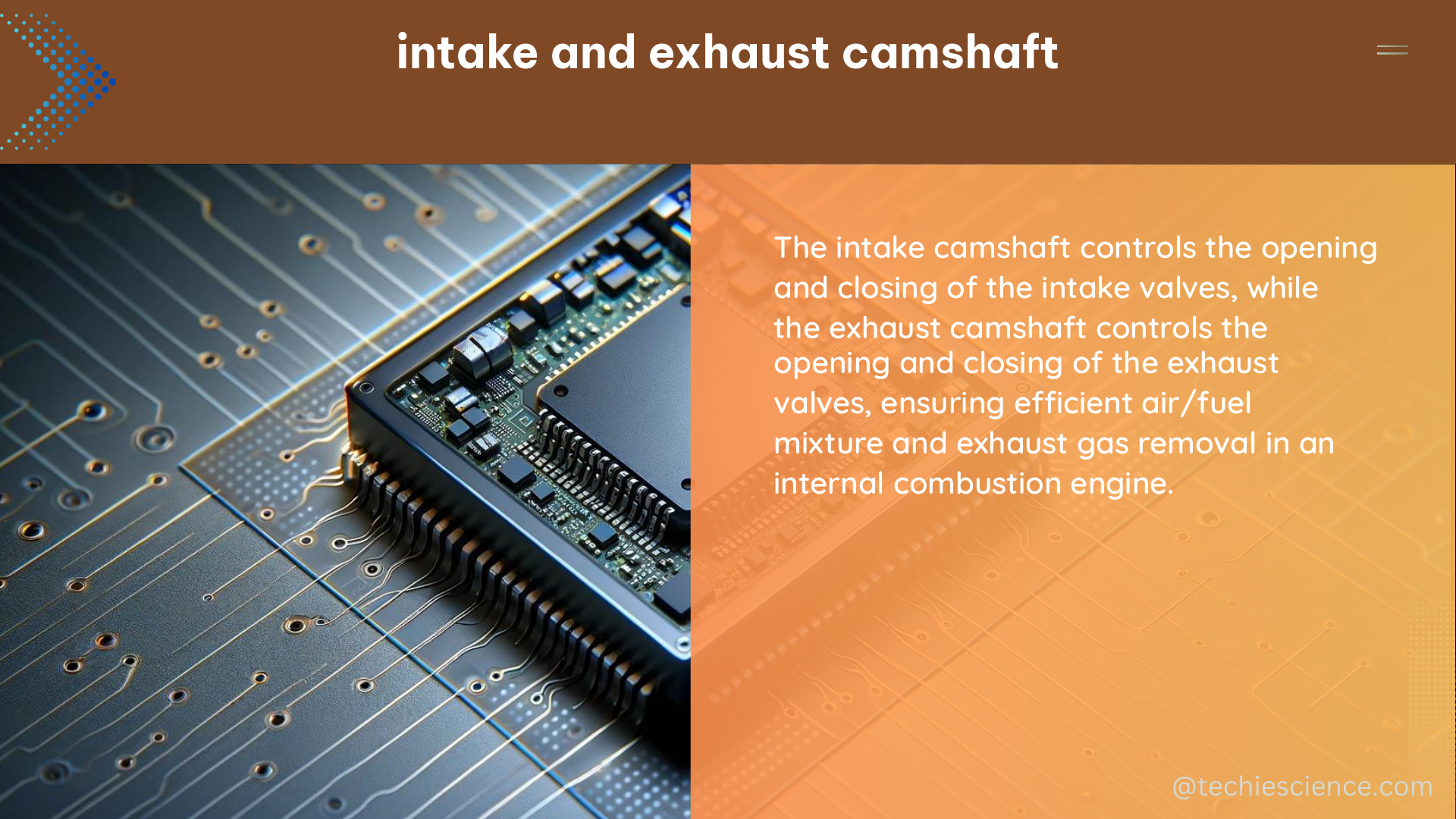Intake and exhaust camshafts are the heart of an internal combustion engine, responsible for precisely controlling the opening and closing of the intake and exhaust valves. These critical components govern the flow of air, fuel, and exhaust gases, directly impacting an engine’s performance, efficiency, and emissions.
Camshaft Profile: The Key to Valve Actuation
The camshaft profile, or cam lobe, is the defining feature that determines the opening and closing duration, as well as the angle, of the valves. A performance-oriented camshaft typically features a more aggressive profile, with longer valve opening times and higher lift. This design allows for increased air and fuel flow, resulting in enhanced engine power and responsiveness.
| Camshaft Profile Characteristics | Typical Values |
|---|---|
| Valve Lift | 0.400 – 0.600 inches |
| Valve Opening Duration | 220 – 280 degrees |
| Valve Overlap | 40 – 80 degrees |
The precise shaping of the cam lobe is a delicate balance, as overly aggressive profiles can lead to increased valve train stress and potential interference issues.
Lobe Separation Angle (LSA): Balancing Performance and Efficiency

The Lobe Separation Angle (LSA) is the angle between the intake and exhaust camshaft lobes. This parameter plays a crucial role in engine performance and efficiency.
- A narrower LSA, typically in the range of 104-112 degrees, can result in improved performance by increasing the overlap between the intake and exhaust valves. This overlap allows for better scavenging of the cylinder, leading to increased volumetric efficiency and power output.
- Conversely, a wider LSA, around 112-118 degrees, can provide smoother engine operation and improved fuel efficiency, but may sacrifice some performance potential.
The optimal LSA is determined by the engine’s intended use, balancing the need for power and efficiency based on the specific application.
Valve Timing: Precision in Valve Opening and Closing
Valve timing refers to the precise moment when the intake and exhaust valves open and close. Adjusting valve timing can significantly impact an engine’s performance, fuel efficiency, and emissions.
- Intake Valve Timing: The intake valve opens before top dead center (BTDC) and closes after bottom dead center (ABDC), allowing the fuel-air mixture to be drawn into the cylinder.
- Exhaust Valve Timing: The exhaust valve opens before bottom dead center (BBDC) and closes after top dead center (ATDC), enabling the expulsion of exhaust gases.
Optimizing valve timing can enhance volumetric efficiency, improve combustion, and reduce emissions. Advanced engine technologies, such as variable valve timing (VVT) systems, allow for dynamic adjustment of valve timing to adapt to different operating conditions.
Valve Spring Pressure: Controlling Valve Actuation
Valve spring pressure affects the speed and force at which the valves open and close. Higher spring pressure can result in improved performance by ensuring the valves close completely and quickly, preventing valve float at high engine speeds.
- Typical Valve Spring Pressures:
- Valve Closed: 80 – 120 lbs
- Valve Open: 120 – 180 lbs
However, excessive valve spring pressure can also increase wear and tear on the valvetrain components, leading to premature failure. Careful selection and tuning of the valve spring system is crucial to balance performance and durability.
Camshaft Replacement and Sensor Diagnostics
DIY enthusiasts can adjust or replace intake and exhaust camshafts to optimize engine performance, but it requires a deep understanding of engine mechanics and precise measurement tools. One common task is the replacement of a faulty camshaft position sensor.
To replace a camshaft position sensor:
1. Identify the sensor’s location, typically near the camshaft or distributor.
2. Disconnect the battery to prevent electrical damage.
3. Carefully remove the old sensor, taking note of its orientation and any mounting hardware.
4. Install the new sensor, ensuring proper alignment and torque specifications.
5. Reconnect the electrical connection and secure the sensor in place.
6. Restore battery connection and verify proper sensor operation.
Proper camshaft sensor diagnostics and replacement are crucial for maintaining engine performance and preventing issues such as misfiring, poor fuel economy, and increased emissions.
By understanding the intricate mechanics of intake and exhaust camshafts, DIY enthusiasts can make informed decisions and perform targeted modifications to extract the maximum performance from their engines. This comprehensive guide provides the technical details and practical steps necessary to navigate the world of camshaft tuning and maintenance.
References:
- HELLA: Check and change ABS and wheel speed sensors
- The International Council on Clean Transportation: Black Carbon Measurement Methods and Emission Factors from Ships
- 2017 FORMULA SAE LINCOLN / ELECTRIC

The lambdageeks.com Core SME Team is a group of experienced subject matter experts from diverse scientific and technical fields including Physics, Chemistry, Technology,Electronics & Electrical Engineering, Automotive, Mechanical Engineering. Our team collaborates to create high-quality, well-researched articles on a wide range of science and technology topics for the lambdageeks.com website.
All Our Senior SME are having more than 7 Years of experience in the respective fields . They are either Working Industry Professionals or assocaited With different Universities. Refer Our Authors Page to get to know About our Core SMEs.